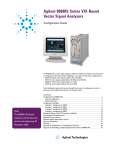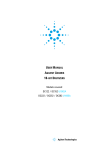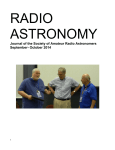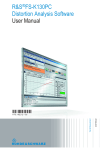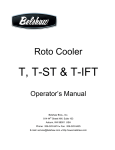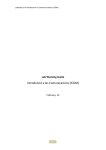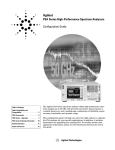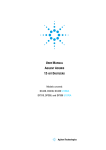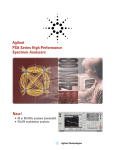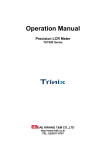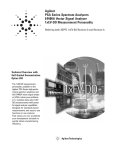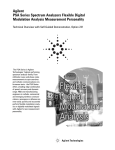Download Agilent Technologies 89600 Webcam User Manual
Transcript
Agilent Acqiris Broadband High-Speed Digitizers Using 89600 Vector Signal Analyzer Software Application Note Vector signal analysis using Agilent Acqiris broadband digitizers. Table of Contents 1 Overview 1.1 89600 VSA software 1.2 Required software revisions 2 Install 89600 VSA Software 3 Hardware Configuration 3.1 I/O between computer and digitizer 3.2 Anti-alias filters and alias exposure-free mode 4 Operation 4.1 Basic operation 4.2 Sampling modes: full rate and user rate 4.3 Differences from 89600 VSA operation 5 Time and Frequency Span Operating Region 5.1 The relationship of main time length, span, and sample rate 5.2 Operating region curves for Agilent Acqiris digitizers 5.3 Recording limits for Agilent Acqiris digitizers 6 Out-of-Band Alias Exposure Zones 6.1 Setting up the alias exposure zone checker 6.2 Using the alias exposure zone checker Appendix A Appendix B Appendix C For More Information Related Literature List 2 3 4 4 5 6 6 7 8 8 8 12 12 12 13 18 19 19 19 23 25 26 28 28 1 Overview This product note describes the characteristics, setup, and operation of a broadband vector signal analyzer (VSA) comprised of an Agilent Acqiris U1066A (DC440, DC438) or U1065A (DC282, DC252, DC222) high-speed digitizer and the 89600 vector signal analyzer software. By taking advantage of the layered architecture and extensive digital signal processing (DSP) routines of the 89600 VSA software, the digitizer becomes a new “front end” data acquisition subsystem for the VSA. This hardware-software combination provides up to 2 GHz of analysis bandwidth depending on the digitizer used. See Table 1 for the supported digitizer models and the corresponding analysis bandwidths. Appendix A contains suggestions for ultra-wideband downconverters. The 10- and 12-bit, high sample rate analog-to-digital converter (ADC) in the Acqiris digitizers produces the large analysis bandwidths shown in Table 1. These bandwidths are capable of providing a spurious-free dynamic range greater than or equal to 40 dB for the U1065A and greater than or equal to 75 dB for the U1066A. This is sufficient for 1.5 to 2% error vector magnitude measurements in most cases. For spectrum measurements with higher dynamic range, a traditional spectrum analyzer should be used. Table 1. Agilent Acqiris digitizers supported by 89600 VSA software Model No of channels Max sample rate Frequency range U1066A-001 (DC440) 1 400 M dc – 100 MHz U1066A-001 (DC440) 2 400 M dc – 100 MHz 4M 8M U1066A-001 (DC440) HF input 1 420 M 1 MHz – 300 MHz1 4M 8M U1066A-001 (DC440) HF input 2 420 M 1 MHz – 300 MHz1 4M 8M U1066A-002 (DC438) 1 200 M dc – 78.125 MHz 4M 8M U1066A-002 (DC438) 2 200 M dc – 78.125 MHz 4M 8M U1065A-001 (DC222) 1 8G dc – 2 GHz 1M 128 M, 1 G U1065A-002 (DC252) 1 8G dc – 2 GHz 1M 128 M, 1 G U1065A-002 (DC252) 2 4G dc – 1.5625 GHz 512 k 64 M, 512 M U1065A-004 (DC282) 1 8G dc – 2 GHz 1M 128 M, 1 G U1065A-004 (DC282) 2 4G dc – 1.5625 GHz 512 k 64 M, 512 M 1. Max span = 164 MHz 3 Default memory Optional memory 4M 8M 1.1 89600 VSA software The 89600 vector signal analyzer software is the heart of the broadband VSA. This software provides flexible tools for analyzing and demodulating even the most advanced digital modulations, including those not defined by an established standard. The VSA makes measurements on signals in the time and frequency domains using either the BB (baseband) or IF Zoom mode. In BB mode, the analysis frequency range is from 0 Hz to the stop frequency. In IF Zoom mode, the analysis frequency range is defined by center frequency and span. There is also an I+jQ mode for analyzing two baseband quadrature channels. Results for any mode can be displayed as magnitude or phase, in I/Q and several other formats. With the optional digital demodulator, Option 89600-AYA, modulation quality measurements in the form of error vector magnitude (EVM) can be made on digital wireless communications signals with bandwidths of hundreds of MHz. In addition, powerful diagnosis capabilities allow you to determine the exact impairments that cause a digitally modulated signal to fail quality standards. The features of the digital demodulator include variable-block-size signal acquisition, pulse burst edge search, synch word search and a user-controllable adaptive equalizer. User-selectable filter types include cosine (raised and square-root raised), Gaussian, lowpass, and user-defined. You can vary the filter alpha/BT shape factor. Supported modulation formats for both burst and continuous carriers include FSK, BPSK, QPSK, OQPSK, DQPSK, π/4DQPSK, 8PSK, QAM (16 to 1024), and MSK. In addition, the 89600 software provides a signal record feature for later playback and analysis. 1.2 Required software revisions Using the 89600 Series VSA software with Agilent Acqiris high-speed digitizers requires compatible software versions: Table 2. Required software versions Agilent Acqiris Software for Windows® AcqirisSoftware 3.2 (Driver AqDrv4.dll 4.13) or later For baseband operation: 89600 VSA Acqiris VSA Server v8.00 or later 1.0 or later For HF operation: 89600 VSA Acqiris VSA Server v9.00 or later 2.0 or later 4 2 Install 89600 VSA Software The 89600 VSA software must be installed on a computer. Installation for standard operation Insert the Agilent Technologies 89600 Series Software CD-ROM in your standard PC and follow the instructions in the installation wizard. When the Installation Manager window opens, click Install 89600 Series Software. In the Hardware Support window, select Acqiris VSA Server. This will avoid installing unnecessary components on your computer. After the software and hardware support is installed, exit the Installation Manager window. Installation for embedded operation Operation of the 89600 Series software on an embedded Compact PCI computer is similar to operation on a standard PC. The instructions for standard operation can be followed here as well using a LAN or USB accessible CD drive. Note: Before you can run the VSA with an Agilent Acqiris digitizer, make sure the Agilent Acqiris digitizer hardware and driver software are installed and configured as directed in the 89600 Series Installation and VXI Service Guide found on your Agilent Technologies 89600 Series Software CD or go to www.agilent.com/find/89600 then click on Technical Support > Manuals. 5 3 Hardware Configuration Connect the digitizer to the computer as shown in Figure 1a or 1b. There are two options for the connection, by remote computer or by embedded computer. 3.1 I/O between computer and digitizer Operation of the 89600 Series software on an embedded Compact PCI computer is similar to operation on a standard PC. The instructions for standard operation can be followed here as well using a LAN or USB accessible CD drive. Agilent Acqiris data acquisition system Agilent Acqir is digitizer 1 2 3 4 Optional anti-alias LPFs Inter face Input Ch 1 (Digitizer Ch 1) Input Ch 2 (Digitizer Ch 2) Figure 1a. Digitizers connected through CompactPCI to PCI interface The digitizers can be connected through various interface types from a CompactPCI crate to either a desktop PC or a portable PC. Agilent Acqiris data acquisition system Agilent Acqir is digitizer 1 2 3 4 Optional anti-alias LPFs Embedded computer Input Ch 1 (Digitizer Ch 1) Input Ch 2 (Digitizer Ch 2) Figure 1b. Digitizers connected through embedded single board PC Alternatively, the digitizers can be controlled by an embedded computer as shown in Figure 1b. 6 3.2 Anti-alias filters and alias exposure-free mode The broadband VSA can be configured to be essentially alias-free by using the full rate sampling mode and installing an external lowpass filter on the digitizer input. Use BNC-f to SMA-m and SMA-f to BNC-m adapters to connect the filter’s SMA connectors to the digitizer in case the digitizer has BNC connectors. Table 3. External lowpass filters Digitizer model Cutoff frequency Filter part number U1066A-002 (DC438) 90 MHz Mini-circuits BLP/SLP-90 MHz2 Mini-circuits1 BLP/SLP-100 U1066A-001 (DC440) 100 U1065A (DC252 (2 ch), DC282 (2 ch)) 1650 MHz Mini-circuits1 SLP-1650 U1065A (DC222, DC252 (1 ch), DC282 (1ch)) 2000 MHz Mini-circuits1 SLP-2000 1. Mini-Circuits, Inc., 1-800-854-7949, www.minicircuits.com. 2. For the HF input a 300 MHz lowpass filter will avoid aliasing from signals above 300 MHz, but in-band and out-of-band aliasing is still possible since full rate mode is not supported with the HF input. 7 4 Operation 4.1 Basic operation Operation of the broadband VSA is substantially the same as that of the 89600 VSA. See the following sections for some differences or special configurations. There is an online Tutorial and Getting Started Guide under the Help/Roadmap toolbar in the 89600 software. 4.2 Sampling modes: full rate and user rate Full rate mode When the Sample Mode is set to full rate using the Utilities/Hardware/ADC1 /Agilent Acqiris One Channel Digitizer/Configure/Sample Mode/Edit menu path for the U1065A-001 or Utilities/Hardware/ADC1 /Agilent Acqiris Two Channel Digitizer/Configure/Sample Mode/Edit menu path for all the other models, the digitizer sample rate is fixed at the maximum for each digitizer model according to Table 4. Table 4. Sample rates of Acqiris digitizers in full rate mode Digitizer model No. of channels Full sample rate U1066A-001 (DC440) 1 400 M U1066A-001 (DC440) 2 400 M U1066A-002 (DC438) 1 200 M U1066A-002 (DC438) 2 200 M U1065A-001 (DC222) 1 8G U1065A-002 (DC252) 1 8G U1065A-002 (DC252) 2 4G U1065A-004 (DC282) 1 8G U1065A-004 (DC282) 2 4G With the addition of the anti-alias lowpass filter described above, this mode is free of alias exposure zones. This means that no signal anywhere in the range of the VSA’s center frequency will alias upon the desired signal and corrupt the measurement. There is a trade-off when using this mode. Although the digitizers have deep memories allowing long record lengths, if a longer Main Time (or Result Length for digital demodulation) is needed for more resolution in the frequency domain a different sample mode may be required. Go to the Configure menu, click on Sample Mode/Edit and select User Rate from the drop-down menu. The Main Time limit for any sample rate is shown in the operating region curves that appear in Appendix C. NOTE: Any limitation to Main Time (or Result Length) will be indicated by the inability of the software to increase the Main Time or decrease RBW when Number of Frequency Points is increased. 8 User rate mode The user rate setting allows you to directly control the digitizer’s sample rate. In this mode you select the digitizer sample rate to be used. The actual sample rate selected will be the highest rate that is less than or equal to the “user sample rate” setting. By controlling the digitizer’s sample rate you can directly influence the update rate of the VSA. This is because sample rate directly affects the number of points the digitizer must transfer to the PC. Certain measurements can be made significantly faster by limiting the digitizer sample rate due to reduced data transfer requirements. There are two types of signal aliasing to be concerned with when using the 89600 VSA application with an Agilent Acqiris digitizer. The first is aliasing of unwanted out-of-band signals into the measurement span. This will not be a problem with the majority of clean, single-signal devices. However, devices with multiple or spurious signals could have this type of aliasing. Section 6 describes how to perform a check to determine if there are any unwanted signals present that can alias down into the measurement span. A second type of aliasing happens when the sample rate causes the in-band signal to fold over on itself. This in-band (or self-) aliasing is avoided in full rate mode by automatically selecting the highest sample rate. However, in user rate mode in-band aliasing may be a problem. To avoid in-band aliasing you must select a suitable sample rate based on your measurement center frequency and span. To avoid in-band aliasing the digitizer sample rate (FS) must be selected so that the analysis span falls within confined regions. Staying within these regions prevents the analysis span from being positioned too close to FS/2. When FS is selected so that the span is confined to be within a single gray box (see diagrams below), in-band aliasing is avoided. See the following table for the equations that describe these in-band alias-free regions. The primary use of user rate mode is to increase maximum waveform length that can be acquired or to increase the update rate. In all cases, user rate measurements must be been carefully engineered to avoid unwanted alias signals. Baseband: DC Fs/2.56 Fs/2 Zoom: n * Fs (n + 1/2) * Fs (n + 1)Fs Figure 2. Avoiding in-band aliasing by selecting FS within a confined span NOTE: User Rate is the only available mode in HF operation. The VSA does not attempt to avoid alias exposure regions when in User Rate mode. 9 This table summarizes the difference in approach to alias protection between the various sample modes: Table 5. Varying approaches for alias protection Full rate Both in-band and out-of-band aliasing are prevented through use of the maximum sample rate and an appropriate lowpass filter. User rate You are responsible to avoid in-band aliasing through appropriate selection of sample rate based on center frequency and span. To ensure no in-band aliasing is present the digitizer sample rate (FS) must be selected to meet this criteria: Baseband: FSTOP ≤ FS/2.56 Zoom: (n*FS)/2 ≤ FCENTER - (1.28 * FSPAN)/2 AND ((n+1)*FS)/2 ≥ FCENTER + (1.28 * FSPAN)/2 where n = 1,2,3,4… Out-of-band aliasing is minimized through use of appropriate low-pass filter. Use of Alias Checker macro (Section 6) is required to detect other unwanted out-of-band signal aliasing. (Note: aliasing of unwanted signals can be eliminated through use of appropriate bandpass filter.) Another concern in user rate mode is that you may see unwanted amplitude variability in two channel measurements. This can occur if any part of the measurement frequency span falls within the regions defined by: (2*n+1) x FS/2 ± 0.1 x FS where n = 1, 2, 3, 4 … where FS is the actual digitizer sample rate. Make sure you choose a sample rate where such overlap does not occur. 4.3 Differences from 89600 VSA operation • • • No Magnitude Trigger (however, Channel Trigger is available). Possible limitation of movement on the operating region curve to avoid alias corruption of the measured signal. This depends on the settings of Center Frequency, Span, Sample Mode, and Number of Frequency Points. There is also potential interference due to the alias products of out-of-band signals. (See Section 6.) No built-in wideband calibrator. The frequency response corrections are determined from factory data. 10 5 Time and Frequency Span Operating Region The operating region curves for the broadband VSAs are different from those of standard VSAs because the Main Time Length may be limited for some sample rate, center frequency, and span combinations. The differences are due to three hardware characteristics of the ultra-wideband ADCs in the Agilent Acqiris digitizers: • • • A much higher sampling rate The lack of a hardware decimator, which means the decimation must be performed by the software from same-length records taken at much higher sampling rates Limited memory capacity 5.1 The relationship of main time length, span, and sample rate The record length or Main Time Length of a measurement is shown in the lower right corner of a spectrum or time display window. This is the length of time the digitizer sampled the input waveform for the measurement. These samples are transferred to the DSP and measurement algorithms running on the software. Maximum Main Time Length is normally adjusted by setting Number of Frequency Points in the MeasSetup/ResBW menu ResBW Coupling is set to Auto, and ResBW mode is set to Arbitrary or 1-3-10. The Time tab can then be used to set Main Time Length up to this maximum limit. This setup keeps Main Time Length maximized and within the DSP requirements. Although Main Time Length can be adjusted directly by the MeasSetup/Time menu, it cannot be greater than the limit imposed by the Number of Frequency Points line on the operating region chart. See the online Help tool for a complete discussion. Note: The maximum Main Time Length can be found as follows: The relationship between the parameters is shown below: Max Main Time Length = Number of frequency points Span where Span = Sample rate 1.28 Max Main Time Length = 1.28 x Number frequency points Sample rate where sample rate = current sample rate computed by the software for aliasfree measurements Maximum Main Time Length may be further limited by digitizer memory depth. 11 5.2 Operating region curves for Agilent Acqiris digitizers Several interrelated characteristics of both the Acqiris digitizers and the 89600 VSA software combine to form a region within which the VSA is constrained to operate. The 89600 VSA software characteristics that affect this operating region include maximum number of time points, the minimum number of time points (not user settable), a maximum acquisition record size (not user settable) and a maximum decimation factor (not user settable). The Digitizer characteristics that affect the operating region are sample rate and memory depth. This section describes the effects each of these parameters has on the VSA operating region. The operating region is described in terms of span and time record length. For a given window type it could just as easily be described in terms of span and RBW. Figure 3 shows the effects of the number of time points the 89600 VSA software is allowed to collect. Because sample spacing is inversely proportional to span, the record length decreases as span increases. Although a family of lines is shown, only two define the operating region at any one time. The lowest line gives the smallest time record length allowed for any given span. The position of this line is determined by minimum number of time points (16) the VSA requires in a time record. The line that defines the upper time record length boundary is positioned by the maximum number of time points the VSA allows in a time record . The maximum number of time points is determined by the Frequency Points setting (MeasSetup/ResBWFrequency Points). The 89600 VSA is constrained to operate in the region between these two lines. Note that the operating lines of Figure 3 are the same for all digitizer models. Operating region: number of frequency points limits 1.E+01 1.E+00 1.E-02 1.E-03 409601 204801 102401 51201 25601 12801 6401 3201 1601 801 401 201 1.E-04 1.E-05 1.E-06 1.E-07 Minimum 1.E-08 1.E+02 Number of frequency points Time record length (sec) 1.E-01 1.E+03 1.E+04 1.E+05 1.E+06 1.E+07 1.E+08 1.E+09 1.E+10 1.E+11 Span (Hz) Figure 3. The user-settable parameter, frequency points, begins to determine the boundaries of the time record length and frequency span operating region 12 In addition to the time record length limits, there are limits to the allowable range of spans. These are represented as vertical lines on the operating region graphs (Figure 4). The upper span limit is set by the digitizer’s sample rate. For the highest sample rate supported by the digitizer this boundary may be further limited by the analog performance of the digitizer’s front-end. To zoom in on a signal of interest by reducing the span, traditional VSA instrumentation reduces the effective sample rate through the use of decimating filters while keeping the ADC at full rate. This technique allows for maximum alias protection. Unlike traditional VSA instruments, the Acqiris digitizers have no decimating filters. To compensate for this shortcoming, decimating filters have been built into the 89600 VSA software. The maximum amount of decimation allowed by the 89600 VSA software sets the minimum span for any given digitizer sample rate. The operating region depicted in Figure 4 is determined by constraints imposed by both time record length and span. The Acqiris digitizers support many sample rates. For each sample rate, the operating region shifts slightly on the operating region graph. As the sample rate decreases, the operating region shifts slightly up and to the left. So, for any given digitizer, there will be a family of overlapping operating regions, one for each supported sample rate. In general, these regions would be the same for every digitizer that supports a given sample rate. The only difference is when the maximum span at the maximum sample rate is limited by analog performance of the digitizer’s front-end rather than just by the sample rate. In addition to the time record length limits, there are limits to the allowable range of spans. These are represented as vertical lines on the operating region graphs (Figure 4). The upper span limit is set by the digitizer’s sample rate. For the highest sample rate supported by the digitizer this boundary may be further limited by the analog performance of the digitizer’s front-end. To zoom in on a signal of interest by reducing the span, traditional VSA instrumentation reduces the effective sample rate through the use of decimating filters while keeping the ADC at full rate. This technique allows for maximum alias protection. Unlike traditional VSA instruments, the Acqiris digitizers have no decimating filters. To compensate for this shortcoming, decimating filters have been built into the 89600 VSA software. The maximum amount of decimation allowed by the 89600 VSA software sets the minimum span for any given digitizer sample rate. The operating region depicted in Figure 4 is determined by constraints imposed by both time record length and span. The Acqiris digitizers support many sample rates. For each sample rate, the operating region shifts slightly on the operating region graph. As the sample rate decreases, the operating region shifts slightly up and to the left. So, for any given digitizer, there will be a family of overlapping operating regions, one for each supported sample rate. Taken altogether, these constraints form an operating region that the 89600 VSA software must remain within (Figure 6). To complete our understanding there are a couple of additional points regarding sampling mode and alias exposure that must be presented. The graphs presented in this section describe discrete operating regions that are a function of sample rate. In full rate or user rate sample modes a single operating region curve fully describes the constraints imposed on the measurement. 13 Operating region: span constraints 1.E+01 1.E+00 1.E-02 1.E-03 1.E-04 Number of frequency points Time record length (sec) 1.E-01 409601 204801 102401 51201 25601 12801 6401 3201 1601 801 401 201 Operating region 1.E-05 1.E-06 1.E-07 Minimum 1.E-08 1.E+02 1.E+03 1.E+04 1.E+05 1.E+06 1.E+07 1.E+08 1.E+09 1.E+10 1.E+11 Span (Hz) Figure 4. The allowable range of spans, which may differ by model, further bound the operating region of the digitizer Operating region: with memory constraints 1.E+01 1.E+00 1.E-02 1.E-03 1.E-04 Operating region 1.E-05 1.E-06 1.E-07 Minimum 1.E-08 1.E+02 409601 204801 102401 51201 25601 12801 6401 3201 1601 801 401 201 Number of frequency points Time record length (sec) 1.E-01 1.E+03 1.E+04 1.E+05 1.E+06 1.E+07 1.E+08 1.E+09 1.E+10 1.E+11 Span (Hz) Figure 5. The digitizer’s available memory also constrains the operating region 14 In full rate sample mode with the use of appropriate lowpass filtering (Table 3) signal aliasing is completely avoided. In this case the “Operating Region” is renamed “Alias Exposure Free Zone” to indicate this special condition. NOTE: Does not apply to HF operation. Although the operating regions for all digitizer models are similar, each model or model family may have important differences in their operating region curves due to differences in maximum sample rate, front-end analog performance, and memory option. Appendix C provides the operating curves for all supported digitizers and most memory options. Operating region: with span and memory constraints 1.E+01 1.E+00 1.E-02 1.E-03 1.E-04 Operating region 1.E-05 1.E-06 1.E-07 Minimum 1.E-08 1.E+02 409601 204801 102401 51201 25601 12801 6401 3201 1601 801 401 201 Number of frequency points Time record length (sec) 1.E-01 1.E+03 1.E+04 1.E+05 1.E+06 1.E+07 1.E+08 1.E+09 1.E+10 1.E+11 Span (Hz) Figure 6. The true operating region is fully described when constrained by all the previous parameters: number of frequency points, span, and digitizer memory. See Appendix C for operating region charts for the various supported digitizers. 15 5.3 Recording limits for Acqiris digitizers The 89600 VSA software allows the acquisition of long records to be captured. Analysis is done as a post-processing operation. This feature is called Recording. Recordings can be much longer than time records in live measurements. Prior to taking a recording, live test measurements of Main Time length are usually made at the desired span. Then, when the recording is made, the analyzer no longer uses Main Time Length but, instead, uses Recording Length to determine length of the acquired record. When making an 89600 VSA recording the maximum recording length is determined by the digitizer sample rate and memory depth. When in user rate the maximum recording lengths will increase as the sample rate decreases. The recording length increase is directly proportional to the sample rate decrease or the memory depth increase. The following table indicates the maximum recording length at full rate for each supported digitizer. Table 6. Maximum recording lengths at maximum span for each digitizer model with memory Model No. of Max span Ch's Recording length for possible memory configurations 512k 1M 4M 8M 64M 128M 512M 1G U1066A-001 (DC440) Std 1 100 MHz − − 10 ms 20 ms − − − − U1066A-001 (DC440) Std 2 100 MHz − − 10 ms 20 ms − − − − U1066A-001 (DC440) HF 1 164 MHz – – 10 ms 20 ms – – – – U1066A-001 (DC440) HF 2 164 MHZ – – 10 ms 20 ms – – – – U1066A-002 (DC438) 1 78.125 MHz − − 20 ms 40 ms − − − − U1066A-002 (DC438) 2 78.125 MHz − − 20 ms 40 ms − − − − U1065A-001 (DC222) 1 2 GHz − 130 μs − − − 16 ms − 130 ms U1065A-002 (DC252) 1 2 GHz 130 ms U1065A-002 (DC252) 2 1.5625 GHz U1065A-004 (DC282) 1 2 GHz U1065A-004 (DC282) 2 1.5625 GHz − 130 μs − − − 16 ms − 130 μs − − − 16 ms − 130 ms − 130 μs − − − 16 ms − 130 ms 130 μs − − − 16 ms − 130 ms − Note: The stated recording depths are at maximum sample rate. Lower user sample rates give proportionally longer times. 16 6 Out-of-Band Alias Exposure Zones As mentioned above, the user rate sampling modes increase the maximum Main Time length at the expense of possible aliasing of out-of-band signals into the frequency span of the measurement. The spectrum ranges subject to the alias conversion are called alias exposure zones. To determine if any out-of-band signals exist in the exposure zones, run the Alias Exposure Zone Checker macro. 6.1 Setting up the Alias Exposure Zone Checker Follow this procedure for setting up the Alias Exposure Zone Checker: 1. Start the VSA application. 2. Click on Utilities\Macros\Recall. Navigate to the Examples\Macros subdirectory in the directory where you installed the VSA application (for example, C:\Program Files\Agilent\89600 VSA\Examples\Macros). Select RecallSetupAfterAliasCheck and AliasChecker files, and click OK. 3. Right click on the top of the VSA application. You will see a popup showing the various toolbars. Select the Macros toolbar. This will make the alias checker icons appear on your VSA application toolbar. 6.2 Using the Alias Exposure Zone Checker The Alias Exposure Zone Checker calculates the frequencies of the alias exposure zones for any combination of center frequency, span, and digitizer sample rate. It then measures the power in each zone and compares it to the power of the desired signal in the span of the measurement setup at the time the checker was started. An unwanted signal in an exposure zone is a source of interference if it is larger than the desired signal’s amplitude minus 40 dB. This –40 dBc threshold is approximately the same level as the quantization errors in the digitizer’s 10-bit digitizer, and represents the limit of the digitizer’s dynamic range. The –40 dBc level is sufficient for 1 to 2 percent EVM measurements. Launch the checker macro by using the tool path Utilities/Macros/Alias Checker or click its icon (shown below) on the bottom of the tool bar. NOTE: The Alias Exposure Zone Checker cannot be used with the U1066A-001 (DC440) HF Input. When the macro stops, a full-span spectrum trace (Figure 7) will appear in Trace A (green). It shows the desired signal plus any unwanted signals. Superimposed is an orange Trace C showing boxes for each exposure zone frequency range. Any unwanted signal falling inside the zone box is a source of alias interference. If the height of any box is higher than the orange reference line, the power in that zone is greater than the –40 dBc threshold of interference. Click Yes in the checker dialog box to return to the original measurement setup. Click No for further examination of the out-of-band signals. You can return to the original measurement setup by clicking the Recall Setup After Alias Check macro icon. 17 Trace C Trace A Figure 7. Alias Exposure Zone Checker results. The desired signal is at 150 MHz and an out-ofband signal is at –35 dBc and 642 MHz. The unwanted signal in the second alias zone is 5 dB above the –40 dBc threshold line. When no alias zones exist because the current sampling mode is alias free, no orange zone boxes will appear. In addition, the message No Alias Zones Detected! Restore Initial Settings? will appear (see Figure 8). Figure 8. Alias checker results when no zones are detected. No orange alias zone boxes appear. 18 When the original center frequency/span is inadvertently tuned to an alias response of a signal whose frequency is not the center frequency, the checker will attempt to suggest the signal’s frequency. The checker results at the desired center frequency location (box formed by white solid and dashed lines) will show no signal, and a large signal will appear in one of the zones, as shown in Figure 9. Further, all zone boxes will be well above the orange threshold line. Figure 9. Alias checker results when the center frequency is originally tuned to an alias product. The checker shows no signal at the desired frequency (white solid/ dashed box) and large zone boxes at the zones containing the desired signal. 19 Appendix A Downconverting RF and Microwave Signals into the Range of the Agilent Acqiris Digitizers External components with wide bandwidths can be used to downconvert signals into the range of the broadband VSAs. The 89600 VSA software can account for the mixing equation of the external downconverter. While the downconverter cannot be controlled by the software, the downconverter’s input center frequency, IF bandwidth, external bandwidth, and IF mirroring can be taken into account by using the Utilities/Calibration / Frequency menu picks. See the Help text for further details on using the external frequency tool. IF out 200 to 500 MHz RF in LO in Bandpass filter: Mini-Circuits BLP-600 IF amp: Mini-Circuits ZFL-500 Figure 10. Block diagram of suggested downconverter. See Table 4 for further details. Table 7. External wideband downconverter details RF range Mixer 0 to 2 GHz (see Table 1) LO IF amp Remarks None None Use digitizer Ch1 or Ch2 (VSA Ch2) 0.2 to 6 GHz Marki1 M2-0006MA 16 to 19 dBm FLO = FRF - FIF Mini Circuits2 ZFL-500 FIF – 200 -500 MHz Mxr: CL = 8 dB, TOI = 18 dBm, Amp: gain = 20 dB, NF = 5.5 dB, TOI = +18 dBm 5 to 40 GHz Marki1 M9-0540IN 3 to 17 dBm FLO = FRF - FIF As above Mxr: CL = 8 dB, TOI = 16 dBm 25.6 to 40 GHz Agilent 11970A 15 dBm FLO = (FRF - FIF)/8 As above 8th harmonic waveguide mixer, Mxr: CL = 22 dB, TOI = 15 dBm 33 to 50 GHz Agilent 11970Q 15 dBm FLO = (FRF - FIF)/10 FIF = 0 – 1 GHz As above 10th harmonic waveguide mixer, Mxr: CL = 24 dB, TOI = 15 dBm 1. 2. Marki Microwave, http://www.markimicrowave.com Telephone: 408-778-4200, FAX: 408-778-4300, 215 Vineyard Court, Morgan Hill, CA 95037 Mini-Circuits, Inc., 1-800-654-7949, 44-1252-83600, http://www.minicircuits.com. 20 Appendix B PC Requirements to Run 89600 Software The 89600 requires a PC connected via the PCI extender to the Acqiris digitizer or an embedded PC. The PC must meet or exceed the following minimum requirements: Characteristic Microsoft® Windows® XP Professional CPU 600 MHz Pentium® or AMD-K6 > 600 MHz Pentium or AMD-K6 (> 2 GHz recommended) Empty slots (desktop) 1 PCI-bus slot (two recommended) or 1 PCIe slot Empty slots (laptop) 1 CardBus Type II slot or 1 ExpressCard slot RAM 512 MB (1 GB recommended) Video RAM 4 MB (16 MB recommended) Hard disk 512 MB available Additional drives CD-ROM or USB storage device to load the software; License transfer requires a 3.5 inch floppy disk drive, network access, or USB memory stick Operating region curves Operating region. Model: Acqiris U1065A (DC222, DC252, DC282) Memory: 1 Mpts 1.E+01 1.E+00 1.E-02 1.E-03 1.E-04 1.E-05 5 Msa/s 10 Msa/s 20 Msa/s 25 Msa/s 50 Msa/s 100 Msa/s 200 Msa/s 250 Msa/s / 500 Msa/s M 1 Gsa/s 2 Gsa/s 4 Gsa/s a Alias exposure free zone * 8 Gsa/s 1.E-06 1.E-07 Minimum Time Rec Len * One-channel operation only. ** Maximum span depends on model number – See Table 1. 1.E-08 1.E +02 1.E +03 1.E +04 1.E+05 1.E+06 Span (Hz) 21 409601 204801 102401 51201 25601 12801 6401 3201 1601 801 401 201 1.E+07 1.E+08 c points Number of frequency 1.E-01 Time record length (sec) Appendix C ** 1.E+09 1.E+10 Operating region Model: Acqiris U1065A (DC222, DC252, DC282) Memory: 256 Mpts and 1024 Mpts 1.E+01 1.E+00 1.E-01 5 Msa/s 10 Msa/s 20 Msa/s 25 Msa/s 50 Msa/s 100 Msa/s 200 Msa/s / 250 Msa/s M 500 Msa/s 1 Gsa/s 2 Gsa/s a 4 Gsa/s 8 Gsa/s 1.E-04 1.E-05 409601 204801 102401 51201 25601 12801 Alias exposure free zone * 1.E-06 6401 3201 1601 801 401 1.E-07 1.E-08 1.E +02 1.E +03 1.E +04 201 Minimum Time Rec Len * One-channel operation only. ** Maximum span depends on model number – See Table 1. 1.E+05 1.E+06 1.E+07 1.E+08 Number of frequency points 1.E-03 ** 1.E+09 1.E+10 Span (Hz) Operating region Model: Acqiris U1066A-001 (DC440) and U1066A-002 (DC438) Memory: 4 Mpts 1.E+01 1.E+00 1.E-01 5 Msa/s 10 Msa/s 20 Msa/s 25 Msa/s 50 Msa/s 100 Msa/s 200 Msa/s 400 Msa/s 1.E-04 409601 204801 102401 51201 25601 12801 6401 Alias exposure free zone *** * 3201 1601 801 401 1.E-05 1.E-07 201 Minimum Time Rec Len 1.E-06 ** ** * U1066A-001 only ** Maximum span depends on model number – See Table 1. *** Alias exposure free zone does not apply to HF Input operation 1.E-08 1.E +02 1.E +03 1.E +04 Number of frequency points 1.E-03 1.E+05 1.E+06 1.E+07 1.E+08 1.E+09 Span (Hz) Operating region Model: Acqiris U1066A-001 (DC440) and U1066A-002 (DC438) Memory: 8 Mpts 1.E+01 1.E+00 1.E-01 1.E-02 1.E-03 1.E-04 5 Msa/s 10 Msa/s 20 Msa/s 25 Msa/s 50 Msa/s 100 Msa/s 200 Msa/s 400 Msa/s 409601 Alias exposure free zone *** * 204801 102401 51201 25601 12801 6401 3201 1601 801 401 1.E-05 Minimum Time Rec Len 1.E-06 1.E-07 1.E-08 1.E +02 201 *** * U1066A-001 only ** Maximum span depends on model number – See Table 1. *** Alias exposure free zone does not apply to HF Input operation 1.E +03 1.E +04 1.E+05 1.E+06 Span (Hz) 22 n points q m of frequency Number Time record length (sec) 1.E-02 Time record length (sec) Time record length (sec) 1.E-02 1.E+07 1.E+08 1.E+09 For More Information For more product literature visit www.agilent.com/find/89600 Related literature list 89600 Series Vector Signal Analyzers Installation and VXI Service Guide Go to www.agilent.com/find/89600 then click on Technical Support > Manuals. Understanding Time and Frequency Domain Interactions in the Agilent Technologies 89400 Series Vector Signal Analyzers, literature number 5962-9217EN 89600 Vector Signal Analyzer CD, literature number 5980-1989E 89600 Series Vector Signal Analysis Software 89600/89600N/ 89601N12, Technical Overview, literature number 5989-1679EN 89600 Series Vector Signal Analysis Software 89600/89600N/ 89601N12, Data Sheet, literature number 5989-1786EN Agilent 6000 Series Digitizers Performance Guide Using 89600 Vector Signal Analyzer Software, literature number 5989-4523EN Hardware Measurement Platforms for the Agilent 89600 Series Vector Signal Analysis Software, Data Sheet, literature number 5989-1753EN 89600 Series Vector Signal Analyzers, VXI Configuration Guide, literature number 5968-9350E 89650S Wideband Vector Signal Analyzer System with High Performance Spectrum Analysis, Technical Overview, literature number 5989-0871EN 89650S Wideband Vector Signal Analyzer System with High Performance Spectrum Analysis, Configuration Guide, literature number 5989-1435EN 89607A WLAN Test Suite Software, Technical Overview, literature number 5988-9574EN 89604A Distortion Test Suite Software, Technical Overview, literature number 5988-7812EN Microsoft, Windows, and XP Professional are U.S. registered trademarks of Microsoft Corporation. Pentium is a U.S. registered trademark of Intel Corporation. Product specifications and descriptions in this document subject to change without notice. 23 Agilent Email Updates www.agilent.com/find/emailupdates Get the latest information on the products and applications you select. Agilent Direct www.agilent.com/find/agilentdirect Quickly choose and use your test equipment solutions with confidence. Agilent Open www.agilent.com/find/open Agilent Open simplifies the process of connecting and programming test systems to help engineers design, validate and manufacture electronic products. Agilent offers open connectivity for a broad range of system-ready instruments, open industry software, PC-standard I/O and global support, which are combined to more easily integrate test system development. www.lxistandard.org LXI is the LAN-based successor to GPIB, providing faster, more efficient connectivity. Agilent is a founding member of the LXI consortium. Remove all doubt Our repair and calibration services will get your equipment back to you, performing like new, when promised. You will get full value out of your Agilent equipment throughout its lifetime. Your equipment will be serviced by Agilent-trained technicians using the latest factory calibration procedures, automated repair diagnostics and genuine parts. You will always have the utmost confidence in your measurements. Agilent offers a wide range of additional expert test and measurement services for your equipment, including initial start-up assistance, onsite education and training, as well as design, system integration, and project management. For more information on repair and calibration services, go to: www.agilent.com/find/removealldoubt www.agilent.com www.agilent.com/find/89600 For more information on Agilent Technologies’ products, applications or services, please contact your local Agilent office. The complete list is available at: www.agilent.com/find/contactus Americas Canada Latin America United States (877) 894-4414 305 269 7500 (800) 829-4444 Asia Pacific Australia China Hong Kong India Japan Korea Malaysia Singapore Taiwan Thailand 1 800 629 485 800 810 0189 800 938 693 1 800 112 929 0120 (421) 345 080 769 0800 1 800 888 848 1 800 375 8100 0800 047 866 1 800 226 008 Europe & Middle East Austria 01 36027 71571 Belgium 32 (0) 2 404 93 40 Denmark 45 70 13 15 15 Finland 358 (0) 10 855 2100 France 0825 010 700* *0.125 €/minute Germany 07031 464 6333** **0.14 €/minute Ireland 1890 924 204 Israel 972-3-9288-504/544 Italy 39 02 92 60 8484 Netherlands 31 (0) 20 547 2111 Spain 34 (91) 631 3300 Sweden 0200-88 22 55 Switzerland 0800 80 53 53 United Kingdom 44 (0) 118 9276201 Other European Countries: www.agilent.com/find/contactus Revised: July 17, 2008 Product specifications and descriptions in this document subject to change without notice. © Agilent Technologies, Inc. 2008 Printed in USA, September 10, 2008 5989-7672EN
























